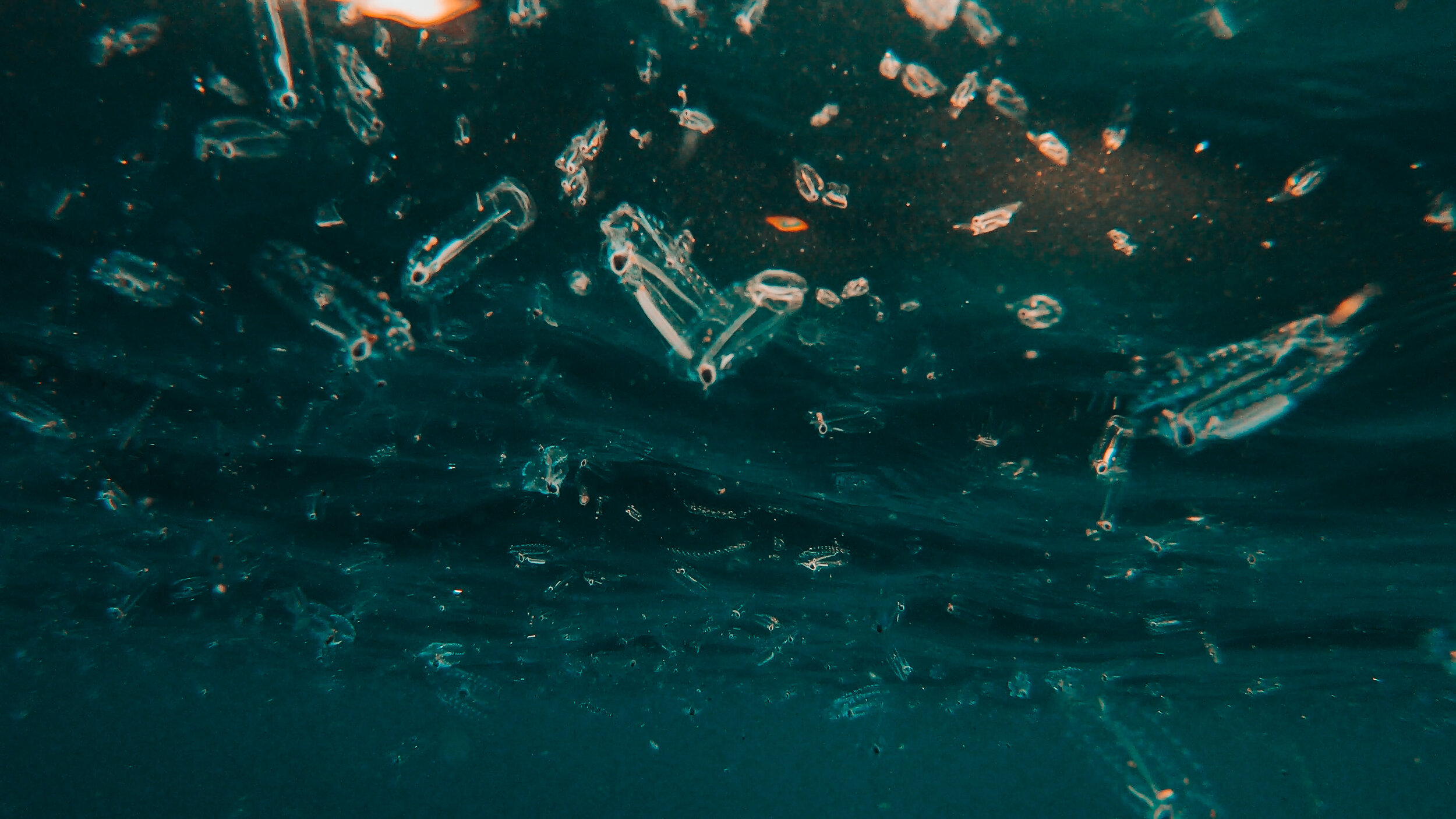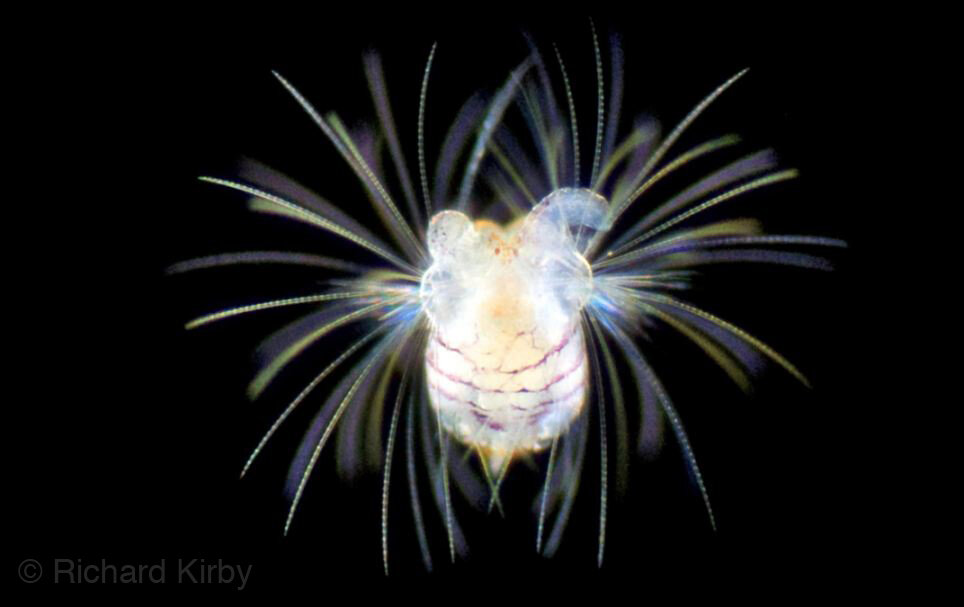The Ocean Drifters: An Introduction to the Planktonic World
Elyssa Quinton
Before I started my Marine Biology degree all I could think about studying was sharks, sharks, and more sharks! I was inspired and encouraged to learn more about marine microbiology and ecology by my favourite lecturer - Dr. Colin Munn. Never would I have thought that my favourite thing to learn about would be the marine organisms you can’t even see…
A group of organisms called the Plankton are amongst the microscopic beings found in the ocean. Plankton (from the greek word Planktos which means 'wanderer’ or ‘drifter’) get carried around by the currents / tides with no ability to swim against them. Most of them you can only see under the microscope, but some are actually quite large in size, such as the jellyfish. Plankton biology and ecology is a diverse and heavily studied subject, with many species that have been discovered and many more to discover!
The planktonic soup at the surface with a beautiful sunset on the Baja peninsula. Winter temperatures bring a high mass of jelly-like organisms such as Ctenophores, salps, tunicates and worms. Photo: Elyssa Quinton.
Phytoplankton
Phyto (plant) plankton are mostly microscopic, single-celled photosynthetic organisms that live suspended in the water column. Some are bacteria, some are protists (1) but most are single-celled plants. Phytoplankton are known as the primary producers of the ocean, forming the base of the food chain, as they create their own food by the process of photosynthesis (the same as land plants). Because they need light, they live near the surface in the euphotic zone, which is often the top 200-300 metres of the ocean. They consume carbon dioxide and release oxygen, so are hugely important in the regulation of our climate. Among the common kinds are cyanobacteria, silica-encased diatoms, dinoflagellates, green algae, and chalk-coated coccolithophores. The amount and distribution of them depends largely on the available nutrients (e.g. nitrate, phosphate and silicate), temperature, salinity, depth, wind and other predators grazing on them.
(1) Protists: a kingdom or large grouping that comprises mostly single-celled organisms such as the protozoa, simple algae and fungi, slime moulds, and (formerly) the bacteria. They are now divided among up in to thirty phyla, and some have both plant and animal characteristics.
Diatoms
One particular type of phytoplankton are diatoms which protect themselves from predators by building houses of glass made from silicon dioxide (silica). Their houses are similar to snowflakes, in a way that each individual diatom is unique and gorgeous! They come in many different forms; filamentous, zig-zag shaped, spirals, and even ribbons. When a diatom dies, the walls act as weights causing the creatures to sink and sequester (lock away) carbon from the atmosphere.
Diatoms come in many forms - this one is particularly intricate. Photo: Richard Kirby.
Phytoplankton blooms
When conditions are right, phytoplankton populations can grow very quickly, a phenomenon known as a bloom! Blooms in the ocean may cover hundreds of square kilometers and are easily visible in satellite images. You may have seen satellite images of the ocean with a milky slick on the surface - this is created by a protist called a coccolithophore. Their limestone plating gives the milky colour. ‘Red Tides’ are also phytoplankton blooms which are known to be caused by a mixture of dinoflagellates and diatoms. These particular algae produce toxins that can sicken humans and be fatal to marine animals. A bloom may last several weeks, but the life span of any individual phytoplankton is rarely more than a few days!
The phenomenon of bioluminescence
Bioluminescence is the production and emission of light by a living organism. The most common planktonic organisms that bioluminesce are dinoflagellates - the fireflies of the sea! The light is produced through a very simple chemical reaction; when oxygen and the biological substances luciferin and luciferase (enzyme) come together, energy is generated and light is produced.
The light emitted can be different depending on the bioluminescent species present - there are various colours! Photo: Pixabay.
Zooplankton
The other type of plankton is the animal form; known as zooplankton. These tiny animals also provide an essential link in the marine food chain. The diversity of species, the amount of biomass, and abundance of zooplankton communities can be used to determine the health of an ecosystem. Zooplankton are either holoplankton (spend their whole life as part of the plankton) or meroplankton (only part of their life is spent in the plankton - most larval forms of sea urchins, sea stars, crustaceans, marine worms, marine snails and most fish!).
A Polychaete worm larva (left) ad crab larva (right). Very different to their adult forms. Photos: Richard Kirby
The most important types of zooplankton include the radiolarians, larvaceans, foraminiferans, dinoflagellates (yes, species of dinoflagellates can be both phytoplankton and zooplankton!), cnidarians, crustaceans, chordates, and molluscs. They all consume a variety of bacteria, phytoplankton, and even other zooplankton species. They are then consumed by animals ranging from small fish (e.g. sardines) and crustaceans (e.g. lobster) to the largest of fish in the ocean (e.g. blue whales). Tiny crustaceans called krill are the main food source for baleen whales (filter feeding). As you can see, they fuel the food chain with yummy protein!
Fun fact: krill have light organs containing Luciferin between each pair of legs which causes bioluminescence!
A Radiolarian - most are round with a complex, beautiful and sculptural skeleton / test. Photo: Pixabay.
Chaetognaths
Also known as arrow worms, these ~3cm holoplanktonic predatory worms have interesting anatomy - including fins on the sides of their bodies, hooked grasping spines on the side of their head, and a hood to cover the bristles when the animal is swimming.
An impressive moment captured by the photographer; an arrow worm (right) that has caught a copepod (left) with its grasping spines. Photo: Richard Kirby.
Cnidarians
This phylum includes the true jellyfish. They are not microscopic but are still described as plankton as they can not swim against a current. They are predatory (although some species photosynthesise!) and use stinging cells on their tentacles (nematocysts - small cells with a retracting barb) to sting and paralyse prey. They have no brain, but instead have a nerve net which senses changes in the environment and coordinates the jellyfish responses.
Jellyfish are the larger members of the zooplankton group. Image: Pixabay.
Larvaceans
These are by far my favourite planktonic species! They are solitary, free-swimming tunicates (in the same phylum as sea squirts) and are found throughout the world’s oceans. They create a test (a kind of skeleton) known as a ‘house’ of protein and cellulose that surrounds the animal like a bubble. The houses contain a complicated arrangement of filters that, when the tadpole-like tunicate beats its tail, draws in seawater. Organic matter is filtered out to provide its food. Once these filters are blocked or the animal increases in size, the houses are discarded and replaced. These discarded larvacean houses account for a significant amount of organic matter (marine snow) descending to the ocean depths. Interestingly, copepods (a type of small crustacean that is considered zooplankton) find these houses and live inside them - check out this video to learn more.
CLIMATE CHANGE AND THE EFFECTS ON PLANKTON
Because plankton are so crucial to ocean biology and climate change, their productivity could have a significant influence on biodiversity, fisheries and human food supply and ultimately the pace of global warming.
Many models of ocean chemistry and biology predict that as the ocean surface warms in response to increasing atmospheric greenhouse gases, phytoplankton productivity will decline. Productivity is expected to drop because as the surface waters warm, the water column becomes increasingly stratified; there is less vertical mixing to recycle nutrients from deep waters back to the surface. Continued warming is predicted to reduce the amounts of larger phytoplankton (such as diatoms), compared to smaller types, like cyanobacteria.
Ocean acidification could weaken diatoms’ glass houses
If greenhouse gas emissions continue on their current track, the average ocean pH will drop from about 8.1 to about 7.8 by 2100. Ocean acidification is caused by the increase of carbon dioxide absorbed into seawater - causing it to become more acidic. In August 2019 scientists showed ocean acidification doesn’t just erode calcium carbonate shells, but can also slow the rate at which diatoms build their intricate silica cell walls. The thinner walls mean lighter diatoms, making the algae less able to transport carbon to the deep ocean when they die. This decreases how much carbon dioxide is sequestered in the oceans.
I really hope you enjoyed reading this introduction to the world of plankton and it inspired you to learn more.
We would like to say a huge thanks to Dr Richard Kirby, an independent scientist, author and filmmaker who captures beautiful images of the plankton found in UK waters. He generously let us use his images in this article. If you would like to continue learning about plankton, and learn more about his work, please visit his website. He also has a fascinating book called Ocean Drifters where you can find more beautiful images.
You can find out more about microbes and Dr. Colin Munn’s work on his blog









